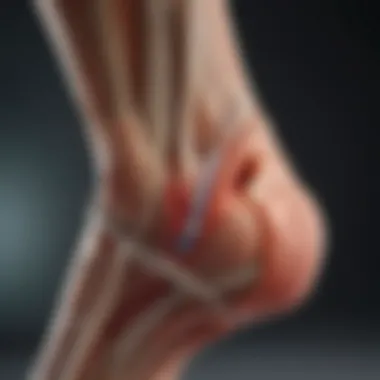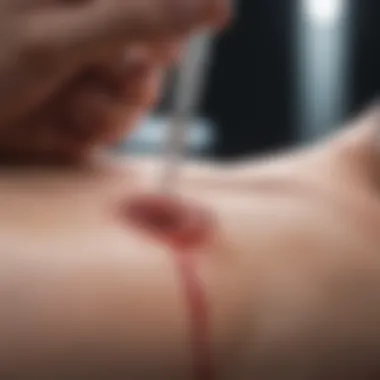Cortisone for Achilles Tendonitis: Detailed Insights


Intro
Achilles tendonitis is a prevalent condition, particularly among those who engage in sports or physical activities. The pain and discomfort associated with this ailment can be debilitating, making treatment essential for recovery. Cortisone, a corticosteroid, is often considered for addressing inflammation and pain in this context. The use of cortisone involves understanding its mechanisms and potential implications, which can provide valuable insights into effective treatment strategies.
This article aims to explore the multifaceted role of cortisone in treating Achilles tendonitis. By examining the mechanisms involved, benefits, and possible drawbacks, we aim to present a balanced view. Additionally, we will evaluate alternative treatment options and underscore the necessity of tailored approaches in managing individual cases for optimal recovery outcomes.
Methodologies
Description of Research Techniques
To offer a comprehensive review of cortisone in treating Achilles tendonitis, various research methods were utilized. Quantitative studies, including randomized controlled trials, help assess the efficacy of cortisone injections compared to other treatments. Surveys and observational studies provide insights into patient experiences and outcomes over time.
These methodologies enable us to gather meaningful data about the impact of cortisone on inflammation, pain relief, and overall function. A systematic review of existing literature also aids in synthesizing findings and identifying patterns or discrepancies in treatment outcomes.
Tools and Technologies Used
The tools employed in this analysis include statistical software for data analysis, enabling the interpretation of numerical data. Additionally, imaging techniques like ultrasound and MRI help in visualizing the condition of the Achilles tendon. These technologies are crucial in diagnosing tendonitis and monitoring the effectiveness of cortisone treatment.
Discussion
Comparison with Previous Research
Many studies have analyzed the role of corticosteroids in tendonitis, contributing to the understanding of cortisone's effectiveness. Previous research often highlighted both the immediate benefits and long-term risks associated with cortisone treatments. This ongoing discourse is essential, as it depicts the complexities of using cortisone in clinical settings, emphasizing that its benefits may vary based on individual circumstances.
Theoretical Implications
From a theoretical standpoint, the use of cortisone illustrates the need for a nuanced understanding of inflammation management in acute and chronic tendon injuries. The decision to utilize cortisone should be informed by clinical evidence, patient history, and the severity of symptoms.
In summary, assessing the role of cortisone in Achilles tendonitis encompasses a blend of empirical data and clinical judgment. By integrating various research techniques and observations, we can better understand how cortisone treatment influences recovery patterns.
Foreword to Achilles Tendonitis
Achilles tendonitis is a common ailment among athletes and active individuals. Understanding it is crucial for grasping the wider implications of treatment options like cortisone injections. This section serves as an essential foundation for the subsequent discussion on cortisone and its role in managing this condition.
Definition of Achilles Tendonitis
Achilles tendonitis refers to the inflammation of the Achilles tendon, which connects the calf muscles to the heel bone. This condition often arises from overuse and is characterized by pain, swelling, and limited mobility.
Causes and Risk Factors
There are several underlying causes and contributing risk factors for Achilles tendonitis that must be understood.
Overuse Injuries
The primary cause of Achilles tendonitis is overuse injuries. These occur when the tendon is subjected to repetitive stress, often without adequate recovery. A key characteristic of these injuries is their gradual development. While they may seem harmless at first, they can lead to severe long-term issues if not addressed early. Understanding overuse as a common cause can highlight the need for proper training regimens and injury prevention strategies.
Athletic Demands
Many athletes face increased demands on their bodies, leading to a heightened risk of Achilles tendonitis. Runners, dancers, and sports players frequently engage in high-impact activities, which can strain the tendon. This aspect emphasizes the need for tailored strength and conditioning programs that take individual athletic demands into account.
Biomechanical Factors
Biomechanical factors also play a significant role. Poor alignment of the foot and ankle can place undue stress on the Achilles tendon. Flat feet or high arches may contribute to uneven weight distribution, increasing the risk of tendonitis. Recognizing these factors may lead to interventions involving orthotics or tailored footwear, aiming to improve biomechanics.
Age and Physical Conditioning


Age and physical conditioning are crucial in the development of Achilles tendonitis. Older adults have a decreased elasticity in their tendons, making them more susceptible to injury. Moreover, individuals who do not maintain proper physical conditioning may find their tendons unable to cope with even moderate athletic pursuits. Thus, continuous assessment of physical fitness is essential for injury prevention.
Symptoms and Diagnosis
Recognizing symptoms early on is essential for effective treatment. Achieving appropriate diagnosis involves thorough examination practices.
Physical Examination
A physical examination is one of the first steps in diagnosing Achilles tendonitis. It often involves checking for tenderness, swelling, and the range of motion of the ankle. A trained medical professional can identify significant findings. This method is a direct and fundamental aspect of any clinical diagnosis.
Imaging Techniques
In some cases, imaging techniques, such as ultrasound or MRI, may be needed for further evaluation. These techniques provide detailed insights into the extent of tendon damage and can rule out other injuries. Their use is significant for clarity.
Differential Diagnosis
Differential diagnosis ensures that Achilles tendonitis is accurately diagnosed among various other conditions with similar symptoms. Conditions such as bursitis or tendinopathy must be excluded. This careful scrutiny ensures that treatment plans are based on the correct diagnosis, maximizing effectiveness.
Understanding Cortisone
Cortisone plays a crucial role in the treatment of inflammatory conditions, particularly Achilles tendonitis. Understanding cortisone helps both practitioners and patients make informed decisions about treatment options. Treatment with cortisone can provide relief from pain and inflammation. This section explores how cortisone functions, its various forms of administration, and specific guidelines regarding its use.
Mechanism of Action
Anti-inflammatory Properties
Cortisone is recognized for its anti-inflammatory properties, which are integral to its effectiveness in treating conditions like Achilles tendonitis. The primary characteristic of cortisone lies in its ability to inhibit the production of inflammatory substances in the body. This is important because inflammation contributes significantly to pain and discomfort associated with tendonitis. Cortisone's unique feature as a corticosteroid allows it to provide quick relief from inflammation, making it a popular choice for doctors when considering treatment plans. However, there are some disadvantages associated with its use, including potential long-term effects on tissue healing if used excessively.
Effect on Pain Perception
The effect of cortisone on pain perception can be profound. It alters the pain pathways in the nervous system, reducing the sensation of pain. This function is beneficial in a clinical setting, where managing pain is a priority for patient recovery. The key characteristic of cortisone in this context is its rapid onset of action, which allows patients to experience relief shortly after administration. While this offers an advantage, the unique aspect to consider is that cortisone may not address the underlying issues of tendonitis, merely masking the pain.
Forms of Cortisone Administration
Injections
Injections of cortisone are one of the most common methods of administration. The precise focus of injections allows for localized treatment directly at the site of inflammation. This targeted approach is advantageous because it can maximize the impact of the medication while minimizing systemic exposure. However, repeated injections can lead to complications such as tendon weakening, which raises concerns about long-term usage.
Oral Medications
Oral medications containing cortisone provide another avenue for treatment, with a focus on systemic effects rather than localized impacts. This method is convenient for patients who may prefer pills over injections. However, oral cortisone can result in a broader range of side effects. These include potential impacts on metabolism and immune function, which should be carefully discussed with a healthcare professional before use.
Topical Applications
Topical applications of cortisone involve creams or gels that are applied directly to the skin. This form targets the surface tissue and can sometimes reduce inflammation without the systemic effects of injections or oral medications. The primary benefit of topical cortisone treatments is a lower risk of side effects compared to other forms. Yet, it may not achieve the same level of effectiveness for deeper tissue inflammation, which is relevant for conditions like Achilles tendonitis.
Indications for Use in Achilles Tendonitis
Cortisone is indicated for use in Achilles tendonitis when conservative measures have not provided sufficient relief. Specific cases may include acute exacerbations of pain or when multiple treatment strategies have failed. It is important to evaluate each case on an individual basis and ensure that the benefits outweigh the potential risks associated with cortisone treatment.
Benefits of Cortisone Treatment
In the context of treating Achilles tendonitis, understanding the benefits of cortisone is essential. Cortisone offers multiple advantages that can contribute to the alleviation of symptoms and facilitate recovery. This section delves into the specific benefits associated with cortisone treatment, namely the reduction of inflammation, pain management, and enhancement of mobility. Each of these elements plays a crucial role in managing Achilles tendonitis, one of the prevalent conditions among athletes and active individuals.
Reduction of Inflammation
Cortisone is primarily known for its potent anti-inflammatory properties. When injected into the affected area, it acts quickly to diminish swelling and redness caused by inflammation. This reduction can be vital for individuals who experience significant discomfort due to tendonitis.


When inflammation subsides, it provides a more favorable environment for tissue healing. Studies show that lower inflammation levels can lead to improved blood flow to the tendons, facilitating recovery. For people dealing with Achilles tendonitis, the acute decrease of swelling can make a notable difference in their day-to-day activities. Without the burden of persistent inflammation, patients can start engaging in rehabilitation exercises sooner, aiding in a more consistent recovery path.
Pain Management
Pain is a hallmark symptom of Achilles tendonitis and can severely limit function and quality of life. Cortisone injections offer an effective means of managing this pain. They do not merely mask the pain; rather, they target the underlying cause by reducing inflammation that often leads to discomfort.
Additionally, cortisone impacts pain receptors, which can provide immediate relief. This effect is beneficial for individuals looking to return to their activities more quickly. They can experience improved levels of comfort during movements previously associated with pain. Although cortisone is not a long-term solution, its role in short-term pain management is critical, especially for those preparing for rehabilitation or sports.
Enhanced Mobility
One of the less discussed yet significant benefits of cortisone treatment is the enhancement of mobility. As pain decreases and inflammation resolves, patients often report improved range of motion and functionality in the affected area. This can significantly affect an individual’s recovery by allowing them to engage more fully in physical therapy.
Cortisone allows earlier stages of rehabilitation to commence by increasing the patient’s confidence in movement and activity. This enhanced mobility leads to a proactive approach to recovery. Importantly, a good mobility level can lead to the prevention of future injuries, encouraging a more stable and healthy state.
Risks and Considerations
Understanding the risks and considerations associated with cortisone treatment for Achilles tendonitis is essential for both practitioners and patients. While cortisone can provide significant relief, it is not without its drawbacks. Recognizing potential side effects, determining the frequency of injections, and acknowledging individual responses to treatment can guide decision-making. Each of these elements is critical in managing the condition effectively while minimizing adverse outcomes.
Potential Side Effects
Tendon Weakness
The aspect of tendon weakness is a significant concern when considering cortisone injections for Achilles tendonitis. Cortisone has strong anti-inflammatory properties, which can temporarily relieve pain and swelling. However, its use can lead to a reduction in tendon strength if not managed properly. This characteristic of tendon weakness is crucial because it may increase the risk of re-injury, complicating recovery.
In this article, understanding tendon weakness as a side effect highlights the need for caution when using cortisone. Effective communication between healthcare providers and patients is vital to address this concern. The unique aspect of tendon weakness is that, while it can provide immediate pain relief, it may compromise the tendon in the long term, making it a less favorable choice for those at risk.
Infection Risks
The aspect of infection risks should not be overlooked in cortisone treatment. Any injection carries an inherent risk of infection. Cortisone injections, particularly in areas like the Achilles tendon, can potentially introduce pathogens into the tissue. This risk is a key characteristic as it emphasizes the importance of aseptic technique during administration.
In the context of this article, the unique feature of infection risks lies in their potential to not only delay recovery but also lead to severe complications if left untreated. Patients must be aware of signs of infection, such as increased redness, swelling, or fever, after receiving cortisone injections. Addressing these risks contributes significantly to creating a well-rounded treatment plan.
Systemic Effects
Systemic effects from cortisone injections are another important consideration. While local treatment is the goal, cortisone can have effects beyond the targeted area. Temporary elevation of blood sugar levels, changes to mood or sleep, and alterations in metabolism can occur. This characteristic is relevant because it can influence patients with preexisting conditions, such as diabetes or those taking other medications.
This article delves into systemic effects since they highlight the broader implications of cortisone use. The unique aspect of systemic effects is that they require monitoring and potentially adjusting treatment protocols. Hence, understanding these effects is crucial for tailoring individualized treatment, ensuring safety while managing Achilles tendonitis.
Frequency of Injections
Deliberating the frequency of injections is integral to smart management of cortisone. Repeated injections can lead to a cumulative risk of side effects, particularly tendon weakening. It is essential to establish guidelines for how often cortisone can be administered, balancing adequate pain control with the potential for adverse effects. Regularly assessing the necessity of injections can help prevent overuse, which may lead to long-term complications.
Individual Variation in Responses
Recognizing individual variation in responses to cortisone is vital in considering its use for treating Achilles tendonitis. Each patient may respond differently based on factors such as overall health, the presence of comorbidities, and individual pain tolerance. This acknowledgment shapes treatment decisions. For instance, some patients may experience significant relief with little side effects, while others may suffer more pronounced complications.
This article emphasizes that individual variability guides practitioners in customizing treatment strategies. Tailoring corticosteroid use to patient specifics can enhance outcomes and preview the importance of personalized care in managing tendonitis effectively.
Alternative Treatments for Achilles Tendonitis
Exploring alternative treatments for Achilles tendonitis is crucial because it offers a holistic view of management strategies beyond cortisone injections. Different therapies can target various aspects of this condition, aiming to reduce pain, enhance recovery, and improve overall function. Understanding these alternatives allows practitioners and patients to make informed choices that align with individual needs and conditions.
Physical Therapy
Physical therapy plays a significant role in treating Achilles tendonitis. It includes tailored exercises designed to strengthen the calf and ankle muscles, which can support the tendon effectively. Therapists often use manual techniques like massage and stretching to alleviate tension and improve flexibility. Education on proper biomechanics during activities is also essential, as it helps prevent further injury. The gradual progression of load during recovery is important, making physical therapy a reliable option for long-term healing.
Nonsteroidal Anti-inflammatory Drugs (NSAIDs)


Nonsteroidal anti-inflammatory drugs, commonly known as NSAIDs, are another prevalent choice for managing Achilles tendonitis. Drugs like ibuprofen or naproxen can reduce inflammation and alleviate pain. They serve as a temporary measure to help individuals engage in rehabilitation exercises more comfortably. However, prolonged use can lead to potential side effects such as gastrointestinal issues, necessitating careful consideration and monitoring by healthcare providers to ensure safety and effectiveness.
Cryotherapy and Heat Therapy
Cryotherapy, or cold therapy, involves applying ice packs to the affected area to minimize inflammation and numb pain. This method is beneficial immediately following injury or during flare-ups. In contrast, heat therapy, often applied through warm towels or heat pads, can enhance blood flow and assist in the relaxation of tightened muscles. Alternating between cryotherapy and heat therapy can offer complementary benefits; cold reduces swelling, while heat improves mobility and promotes healing.
Surgical Options
Indications for Surgery
Surgery may be recommended for patients with chronic Achilles tendonitis who do not respond to conservative treatments. Surgical intervention is usually indicated when there is significant damage to the tendon or when debilitating pain restricts daily activities. The key aspect of this intervention is that it aims to repair the tendon structure, making it a potentially beneficial choice for those experiencing prolonged issues. As with any surgical option, it comes with inherent risks, but for some individuals, it provides a pathway to restored function.
Postoperative Considerations
Postoperative considerations following Achilles tendon surgery are critical to ensuring a successful recovery. These considerations include a structured rehabilitation program to facilitate healing and restore mobility. Early movement is essential to prevent stiffness, while proper footwear and activity modifications can support healing. Patients must also be aware that recovery may take several months and that adherence to postoperative guidelines significantly influences the overall outcome.
By exploring these alternatives, individuals can develop a more comprehensive understanding of managing Achilles tendonitis effectively. Each treatment modality offers unique benefits and considerations, enabling personalized treatment plans that consider individual circumstances.
Case Studies and Evidence Review
The exploration of case studies and evidence related to the use of cortisone for Achilles tendonitis serves as a crucial section in understanding the practical implications of theoretical knowledge. Case studies provide real-world context that clinical trials may not fully encapsulate, thereby offering insight into treatment efficacy among diverse patient populations. Furthermore, these narratives can emphasize individual responses to treatment, which can starkly differ from the average outcomes found in broader studies. This depth adds significant value to the discourse surrounding the management of tendonitis.
By examining both clinical trials and actual patient experiences, one can better evaluate the advantages and potential limitations of cortisone therapy.
Clinical Trials on Cortisone Use
Clinical trials form the backbone of evidence-based medicine. They assess the safety and effectiveness of cortisone injections in treating Achilles tendonitis within controlled environments. These studies typically involve a sample size that reflects the wider population, including various demographics such as age, activity levels, and pre-existing health conditions.
Key Findings from Recent Trials:
- Pain Relief: Many trials report significant reductions in pain levels among subjects receiving cortisone injections. This is often measured using validated pain scales.
- Functional Improvement: Studies have shown that cortisone can enhance mobility, allowing individuals to return to their daily activities or sports quicker than with other treatment modalities.
- Duration of Effects: The duration of pain relief varies. Some studies note sustained effects for weeks, while others report shorter-term relief, triggering ongoing discussions about ideal treatment protocols.
Cortiosteroids like cortisone have undergone scrutiny for their long-term effects on tendon strength and recovery times. This aspect remains a significant consideration for practitioners when deciding on treatment pathways.
Real-World Outcomes
Transitioning from clinical trial results to the real-world application provides an important perspective. Anecdotal evidence gathered from patients highlights variations in treatment outcomes influenced by factors like adherence to rehabilitation programs, the severity of tendonitis, and overall physical condition.
Insights from Patient Experiences:
- Variability in Response: Few patients experience ideal results. Some achieve nearly complete relief from symptoms, while others may feel minimal improvement even after multiple injections.
- Need for Comprehensive Treatment Plans: Many individuals find that cortisone alone is insufficient. Combining it with physical therapy tends to yield better overall results, as rehabilitation can bolster tendon health and minimize recurrence.
- Personal Health Factors: Patient histories, such as chronic diseases or prior injuries, significantly affect treatment success. Therefore, pre-treatment assessments can aid in tailoring specific interventions that accommodate individual needs.
"Real-life outcomes often diverge from clinical studies, necessitating personalized approaches in treating Achilles tendonitis effectively."
Finale
The conclusion serves as a vital synthesis of the comprehensive review on cortisone for treating Achilles tendonitis. In this section, we encapsulate the main insights highlighted throughout the article, reaffirming the significance of cortisone in managing a condition that impacts many athletes and physically active individuals.
Summary of Findings
Cortisone presents a dual advantage when it comes to treating Achilles tendonitis. First, it alleviates the chronic inflammation often associated with the condition. Clinical evidence suggests that cortisone injections can lead to a notable reduction in pain, enabling patients to resume their activities with improved ease. However, the long-term efficacy of cortisone treatment indicates the need for caution, particularly in terms of potential side effects such as tendon weakness and risk of infections. The body of evidence reinforces that while cortisone can provide immediate relief, its effectiveness can vary from patient to patient.
Cortisone offers short-term benefits for pain relief, but it does not address the root causes of tendonitis.
Additionally, alternative treatments, such as physical therapy and NSAIDs, were discussed as viable options. These alternatives, often more sustainable, can complement cortisone therapy or serve as primary treatment when appropriate. The review highlights that a tailored approach, considering individual patient needs, is crucial for effective management.
Future Directions in Treatment Protocols
Moving forward, research must focus on refining treatment protocols for Achilles tendonitis to optimize patient outcomes. The role of cortisone continues to be a focal point, yet understanding individual variability in response will be essential. Future studies should aim to elucidate the best practices for integrating cortisone with other treatment modalities, such as rehabilitation exercises and lifestyle modifications.
Moreover, investigating the molecular mechanisms of cortisone in relation to tendon healing could pave the way for more targeted therapies in the future. Such studies could potentially unveil alternatives that may minimize risk while maintaining or enhancing effectiveness.
Ultimately, collaboration between practitioners and researchers must foster an environment that prioritizes evidence-based solutions for managing Achilles tendonitis, ensuring athletes regain their functionality swiftly and safely. An integrative approach, combining various treatment options, may very well define future protocols in this dynamic field.



